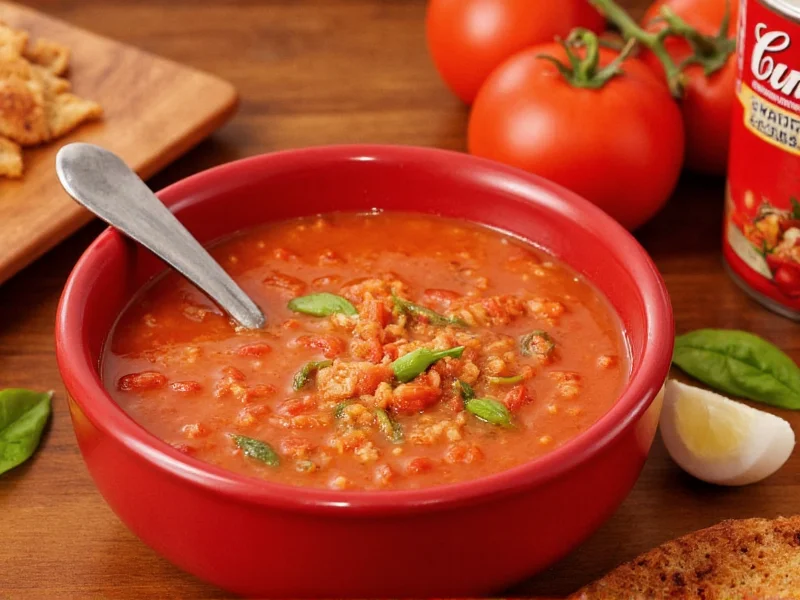For over a century, Campbell's Tomato Soup has remained a pantry staple in American households, transcending its simple origins to become a culinary canvas for home cooks. Its enduring popularity stems from consistent quality, versatile flavor profile, and remarkable adaptability in countless recipes beyond basic preparation. Understanding how to maximize this familiar product requires examining both its composition and creative potential.
What Makes Campbell's Tomato Soup Unique
The distinctive character of Campbell's condensed tomato soup comes from carefully selected tomato varieties processed at peak ripeness. Unlike many competitors, Campbell's uses a specific blend of tomato concentrates that creates a balanced sweet-tart profile without requiring added sugar. The inclusion of wheat flour as a thickener (rather than cornstarch) contributes to its signature smooth texture that holds up well when incorporated into more complex dishes.
Nutritional Profile Analysis
Understanding campbell's tomato soup nutrition facts helps consumers make informed choices. The condensed nature means sodium content appears high per can, but proper preparation with the recommended amount of water brings sodium to reasonable levels. Recent formula adjustments have reduced sodium by approximately 30% compared to earlier versions while maintaining flavor integrity through improved tomato selection and processing techniques.
| Nutrient | Per ½ Cup Prepared | % Daily Value |
|---|---|---|
| Calories | 100 | 5% |
| Total Fat | 0g | 0% |
| Sodium | 490mg | 21% |
| Total Carbohydrate | 20g | 7% |
| Sugars | 8g | - |
| Vitamin A | 15% | 15% |
| Vitamin C | 40% | 40% |
Optimal Preparation Techniques
Mastering classic campbell's tomato soup preparation significantly impacts final quality. The recommended ratio is one can of soup to one can of water or milk. When using milk instead of water, add it gradually while heating to prevent curdling. For restaurant-quality results, professional chefs recommend simmering the prepared soup for 8-10 minutes after mixing to allow flavors to fully integrate. Never boil condensed soup vigorously after preparation, as this breaks down the delicate tomato structure and creates an unpleasant texture.
Creative Recipe Enhancements
Transforming basic campbell's tomato soup into something extraordinary requires minimal additional ingredients. Consider these chef-tested improvements:
- Umami Boost: Stir in one teaspoon of soy sauce or Worcestershire sauce per can for deeper flavor complexity without making the soup taste Asian-inspired
- Creamy Texture: Substitute half the liquid with heavy cream or coconut milk for luxurious mouthfeel while maintaining tomato prominence
- Herb Infusion: Simmer with fresh basil or oregano sprigs for 5 minutes before serving (remove before serving)
- Acidity Balance: A small splash of balsamic vinegar (¼ teaspoon per can) brightens flavors without making the soup taste vinegary
- Texture Enhancement: Blend half the soup and return to the pot for richer consistency without additional thickeners
Historical Context and Cultural Significance
Since its introduction in 1897, Campbell's Tomato Soup has evolved from a simple convenience food to an American cultural icon. The distinctive red-and-white label design, largely unchanged since 1898, represents one of the longest-running consistent branding exercises in commercial history. During World War II, the soup's shelf stability made it a staple in military rations, further cementing its place in American food culture. The product's association with comfort during illness stems from its gentle acidity and familiar flavor profile that appeals even when appetite is diminished.
Perfect Pairings for Campbell's Tomato Soup
Certain accompaniments elevate campbell's tomato soup from simple meal to satisfying experience. The classic grilled cheese sandwich pairing works because the fat in cheese balances tomato acidity, while the crunch provides textural contrast. For more sophisticated pairings:
- Crostini with garlic and olive oil adds crunch without overwhelming the delicate tomato flavor
- Crumbled feta or goat cheese provides salty contrast that complements tomato sweetness
- Roasted vegetable medley (zucchini, bell peppers, eggplant) creates a heartier meal while enhancing vegetable notes
- Cracked black pepper and fresh basil added just before serving creates restaurant-quality presentation
Storage and Shelf Life Guidelines
Unopened cans of Campbell's Tomato Soup maintain quality for 18-24 months when stored in cool, dry conditions away from direct sunlight. Once opened, transfer unused portions to airtight containers and refrigerate for up to 3 days. Never store opened soup in the original can, as metal can impart off-flavors. For longer storage, freeze prepared soup in portion-sized containers for up to 3 months. Thaw frozen soup overnight in the refrigerator before reheating gently over medium-low heat.
Common Questions About Campbell's Tomato Soup
Many home cooks wonder about specific applications and modifications for this versatile product. Understanding these aspects helps maximize its potential in everyday cooking while addressing common concerns about ingredients and usage.











 浙公网安备
33010002000092号
浙公网安备
33010002000092号 浙B2-20120091-4
浙B2-20120091-4